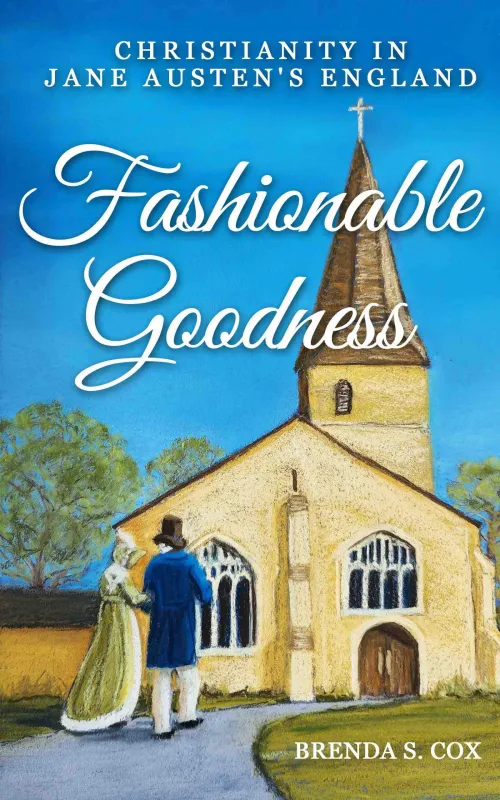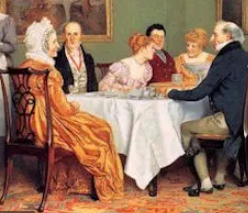They had a very fine day for Box Hill … Nothing was wanting but to be happy when they got there. Seven miles were travelled in expectation of enjoyment, and every body had a burst of admiration on first arriving…Jane Austen, Emma
One of the most famous scenes in Emma is the picnic scene on Box Hill. Picnics were becoming increasingly popular at the turn of the nineteenth century, when romantic sensibility influenced the trend of eating out of doors as a way to commune with nature. According to the Oxford English Dictionary, the term picnic originally meant “A fashionable social entertainment in which each person present contributed a share of the provisions; now, A pleasure party including an excursion to some spot in the country where all partake of a repast out of doors: the participants may bring with them individually the viands and means of entertainment, or the whole may be provided by some one who ‘gives the picnic’. ”
Even though picnicking became increasingly popular, arranging one was often no easy matter. According to Andrew Hubbell, author of How Wordsworth Invented Picnicking and Saved British Culture*:
To picnic is to consume not only particular food, but also a specific environment chosen according to an aesthetic standard, and a particular form of sharing food according to certain standards of behaviour. It means creating a moveable feast and overcoming difficulties and inconveniences, not only for preparation and transportation,but also for consumption and cleanup. Yet picnicking is the pleasurable pursuit of a leisured people, so the difficulty of moving the feast has some reward. The reward is primarily ideological: it enables the participant to share a form of eating that creates relationships between small groups of people, natural landmarks, and cultural ideals. These relationships form a consciousness of national identity. Picnicking, especially for early nineteenth-century picnickers, was thus away of performing Britishness.
This Romantic aesthetic can be witnessed in the A&E version of Emma, to be show on PBS this Sunday. Box Hill, the setting of Emma’s famous picnic, and comprising of woods and grassland, offered a spectacular view of the surrounding countryside. The experience of eating in such a beautiful setting would appeal to both the eye and palate. Box Hill is covered with box trees, yew trees. and beeches and oaks. To this day, the area is filled with flowers and the sound of bird song, and fully two-thirds of the British butterfly species have been recorded at this site.**
As is still the custom, each member or group invited to a regency picnic brought a dish, usually carried in wicker baskets, for the others to enjoy. In this way a variety of dishes would be shared and tasted. However, without someone to guide them, guests would often bring similar foods. As picnics became more organized and elaborate, one person would take charge of assigning the dishes, ensuring the non-duplication of foods, or a host would offer to take over the responsibility of providing all the food.
As the 1997 A&E film demonstrates, these elegant and sumptuous picnics were not easy to accomplish. Teams of horses were arranged to transport wagons with picnickers, servants, food, and outdoor furniture. If the picturesque spot was located in an out of the way place, the party had to walk the remainder of the way with the supplies. The servants would lay out the dishes, and tables and cloths al fresco. After the parties had dined, these supplies needed to be repacked.
In the film, the servants were shown constantly working to provide a leisurely and pleasurable outing for the picnickers. Their hard work was for naught, however, since no one in the party, most particularly Emma, seemed to be having a good time. As the afternoon progressed, the underlying tension among the diners erupted with Emma’s cruel comment towards Miss Bates.
The Box Hill scene in Emma is pivotal. After Emma insults Miss Bates, Mr. Knightley angrily confronts her about her behavior. Unable to remain blind to her own faults, Emma begins to change and grow. She realizes how much she craves Mr. Knightley’s good judgment, which leads her to a later revelation that she loves him.
Interestingly, at the strawberry-picking at Donwell Abbey the day before, Mr. Knightley says to Mrs. Elton: “The nature and the simplicity of gentlemen and ladies, with their servants, and furniture, I think is best observed by meals within doors.” Given how utterly the Box Hill excursion failed to entertain the picnickers, his words were prophetic.
To read more about the origins of picnics, and about Box Hill, click on the long list of links below.
Box Hill, Emma
- *How Wordsworth Invented Picnicking and Saved British Culture, Andrew Hubbell
- Re-reading Box Hill: Box Hill and the Limits of Realism, George Levine, Rutgers University, Romantic Circles, Praxis Series
- Emma at Box Hill: A Very Questionable Day of Pleasure, Susan Rogers, Persuasions On-line
- Leaving Box Hill: Emma and Theatricality, Adam Potkay, College of William and Mary
Physical Setting of Box Hill
- Box Hill: The County and Environment, The National Trust
- **North Downs Way: National Trail, Box Hill
The History of Picnics
Technorati Tags: Box Hill, Emma 1996, Emma 1997, Picnicking in the Regency Era, Regency Servants








Always lovely to visit your site. I am back home now, was gone for over 1 month, my mother died on March 2.
Thank you for your friendship.
[…] all about Emma’s Box Hill picnic at Jane Austen’s […]
[…] Emma: Picnicking on Box Hill […]
[…] Emma: Picnicking on Box Hill […]
[…] Read my post Picnicking on Box Hill here. […]
[…] next to their abode that they can enjoy? What about a picnic scene? You could take inspiration from Jane Austen’s Emma and have a grand affair, make it more low key and treat it as afternoon tea on the terrace, or […]
[…] Emma: Picknicking on Box Hill […]
[…] when your servants would walk behind you lugging baskets, umbrellas and half a marquee (I found this brilliant Jane Austen blog which describes the elegance and guargantuan effort of picnics in those days). It was after a […]
So interesting came from Australia with friend who visited there as a child while holydaying from Hackney in London.Caught bus from Dorking and climbed up hill from alongside Pub.It was a long climb for a eighty three year old but it was worth it,went down by steps and across the stepping stones ,caught bus to Dorking station and back to London tired but having seen a lovely place.
[…] Emma: Picnicking on Box Hill […]
[…] Click here for a nice anthology of links around Regency Era picnicking {LINK}. […]
[…] Hill is another place I’d been wanting to visit for a while, having first encountered it in Jane Austen’s ‘Emma’ (although I have always wondered if the Box Hill mentioned there was the one in Bath, which I now […]